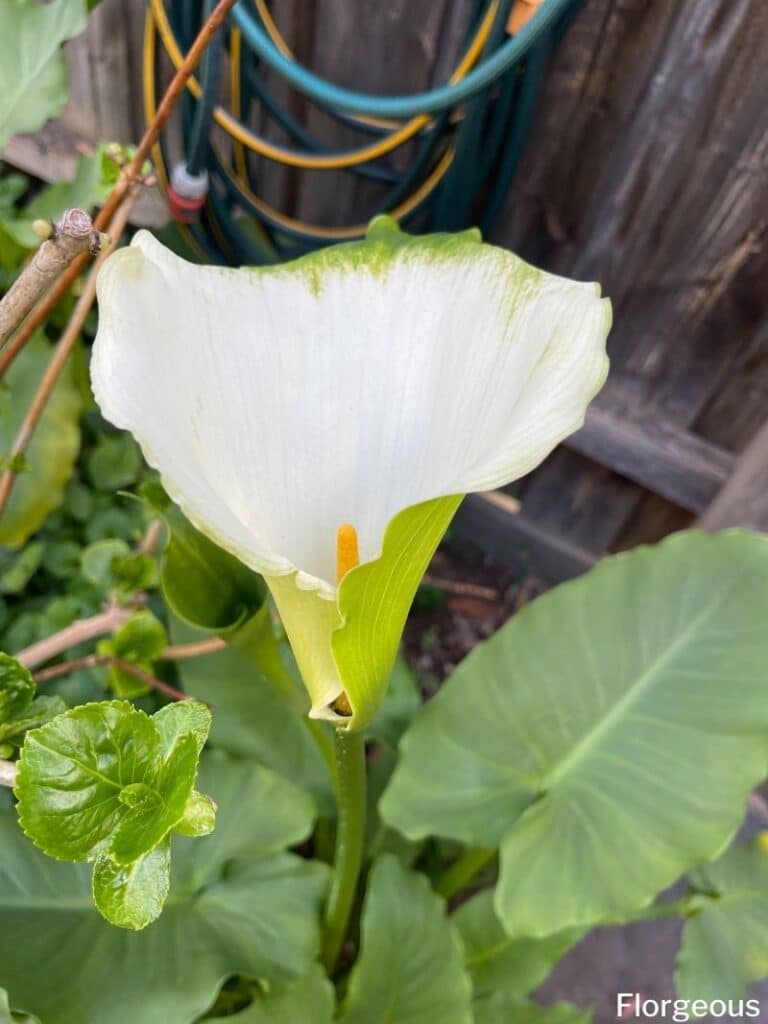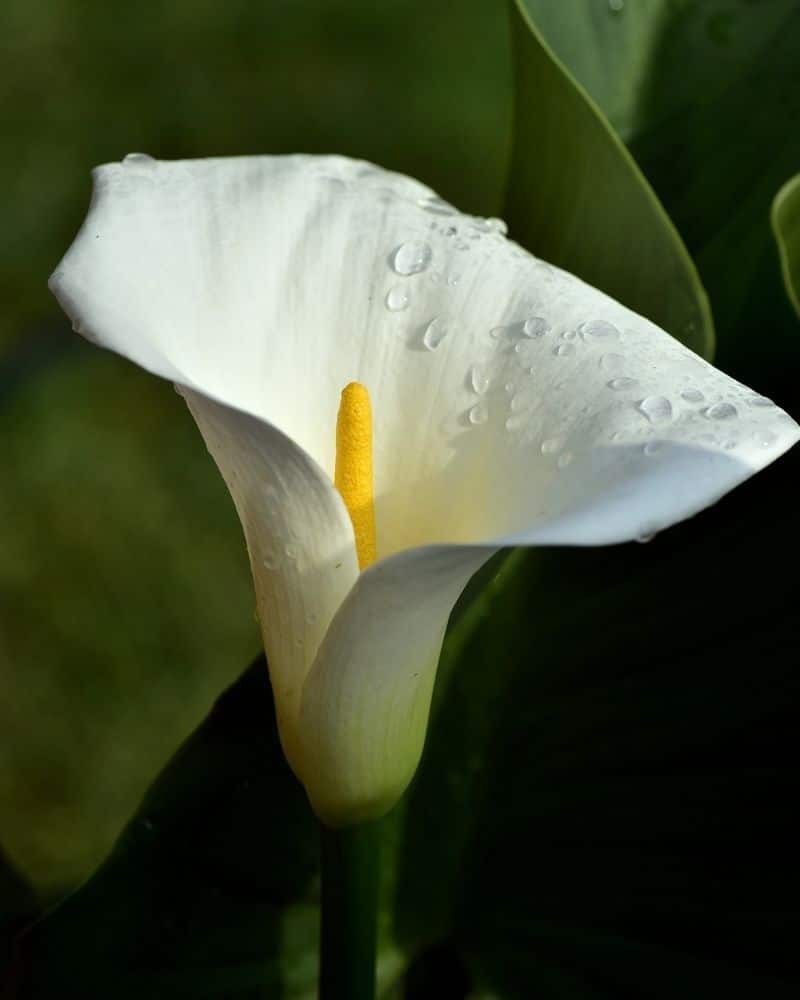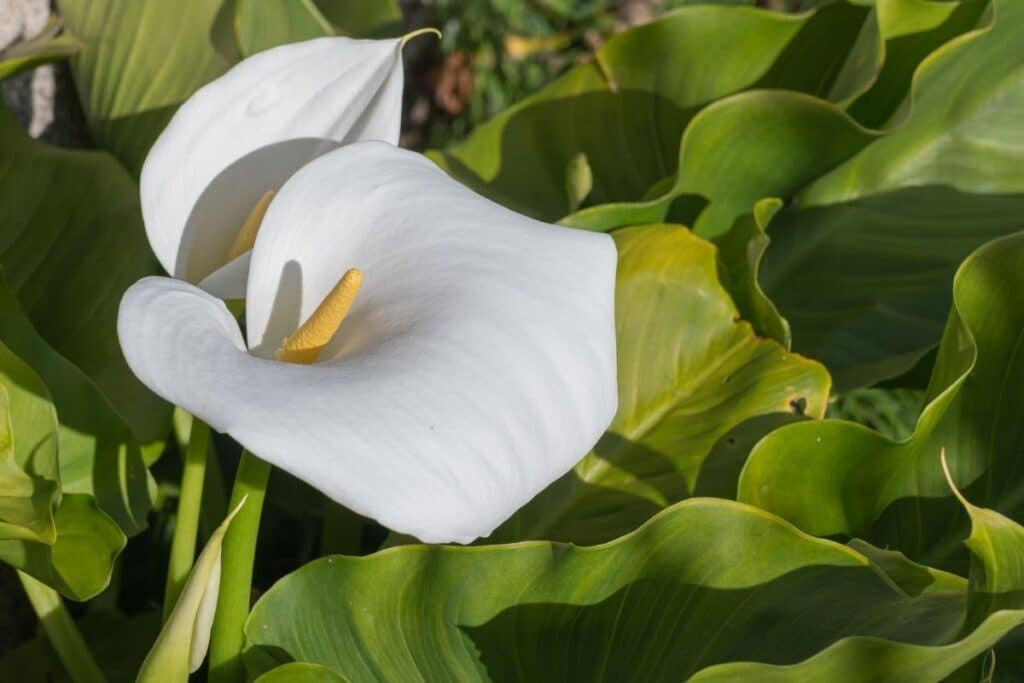Interested in learning how to grow calla lilies or Zantedeschia aethiopica? You’ve come to the right place! In this article, we’ll tell you everything you need to grow a garden filled with these delicate beauties.
These flowers are known for their long, elegant stems and big, beautiful blooms. These plants can be difficult to grow in some climates but when grown correctly they will thrive and produce flowers year after year.
Here are some tips to help you grow your own calla lilies – regardless of your experience level or expertise.
What Are Calla Lilies?
Callas are flowering plants that are part of the Araceae family and the Zantedeschia genus. The genus contains several different perennial, herbaceous flowering plants that are native to Africa.
Despite this limited range, calla lily plants are now grown on just about every continent – with the exception of Antarctica. They have colorful flowers and decorative leaves that make them the perfect specimens for growing in borders, as individual plantings, or even in containers.
Calla lilies are extraordinary flowers that grow from rhizomes and can be grown outdoors or even in sunny windowsill, as houseplants.
Growing Calla Lilies
Growing these flowers is relatively straightforward. Plant them in full sun with a little bit of partial shade, ideally in moist, humus-rich soil. These flowers can even be grown in boggy soil! Adding a thick organic mulch can help them survive long winters in cooler climates.
You can even grow these lilies in containers indoors, if you choose. You will normally plant them in the spring but you can also plant seeds in the fall in warm areas.
When you are growing calla lilies, it is important to note that they can be highly toxic. In fact, if eaten, they can be fatal, causing severe burning and swelling of the throat, tongue, and lips along with stomach pain and diarrhea.
Though beautiful, it is important to keep these flowers away from children and pets to avoid this risk. All parts of the plant, from stem to seed, are poisonous.

How to Plant Calla Lily
Prepare the soil ahead of time. It should be well-drained or, if you are growing in a container, use a quality potting mix instead of regular gardening soil. These calla lilies grow best from rhizomes. Plant them to a depth of two inches and space them 18 inches apart. In contains, you can space them closer together for a fuller appearance.
You can propagate the flowers by separating the cormels or sowing seeds in the fall. Dig a hole that is about three to four inches deep, then set your lily into the hole with the eyes, or growing tips, facing you. Cover with soil and water lightly.
If you dig the tubers to store over the winter, store them at around 50 to 60 degrees Fahrenheit. Note that this step is not necessary if you grow calla lilies in an area where they can overwinter with mulch (typically zone 8 or warmer). Be careful when storing the bulbs so as not to damage them.
When you first plant your rhizomes, be sure to water them sparingly to avoid oversaturation. Once the plants develop several sets of leaves, you can water more liberally. It can take up to two weeks for the first shoots to appear, but once they do, the plants will grow rapidly.
If you plant callas in the spring, flowering will typically be delayed until later in the summer.

Calla Lily Care and Maintenance
Here are some tips to help you care for your calla lily flowers regardless of where you live or what the season might be.
Watering
It’s important not to overwater your lilies, particularly after you’ve just planted the rhizomes. This can cause them to rot and they will never produce flowers.
Once your plants are established, you can water once a week (or perhaps even more often if the weather is exceptionally hot or conditions are drought-like). Keep in mind that plants grown in containers, as well as those grown callas indoors, will require more frequent watering, as containers dry out faster than plants grown in the ground.
It’s equally important to keep an eye on the temperature and humidity. These potted calla lilies prefer temperatures around 70 to 80 degrees Fahrenheit along with lots of humidity – they are semi-tropical plants, after all!
Humid summers make these plants happy. When temperatures dip below 50 degrees, your lilies will likely go dormant. Therefore, it’s important to dig up rhizomes for overwintering early in the fall.
Weeding
Keep the area around your calla lilies free of weeds, especially when the calla rhizomes are first establishing themselves. Weeds compete heavily with flowers for nutrients, space, and water.
They can also transmit diseases and pests. Use a mulch around your lilies to help moderate moisture, warm the soil, and prevent weed seeds from germinating. You can also cultivate by hand, if desired.
Fertilizing & Overwintering
Most well-balanced fertilizers work just fine for calla lilies. However, be sure to avoid one with too much nitrogen, as this can encourage leafy green growth at the expense of flowers.
Liquid fertilizer is essential when growing these plants, especially if you plan on overwintering callas for the following year.
Fertilize regularly throughout the growing season with an all-purpose flour fertilizer. Then, cut the flower stems when the blooms have faded. This will prevent the calla lily plant from setting seeds so it can conserve energy for flowers the following year.
Fertilize until the foliage is yellow. Once the leaves die back (or after the first frost), you can dig up the rhizomes and cut the foliage, leaving just one or two inches of stem attached. Allow the rhizomes to cure in a dry, warm place for a few days, then put them in a box with damp peat moss.
This box, as mentioned, should be stored at temperatures around 50 to 60 degrees Fahrenheit. Check on the rhizomes regularly throughout the growing season to make sure they aren’t too dry or wet.
Pests and Diseases
There are a few diseases and pests to watch out for, most of which are related to excess moisture.
Bacterial soft rot is one such disease. It affects primarily the rhizomes and is most commonly introduced when the plants are injured during planting or digging. If you notice any damaged rhizomes, discard them rather than planting, as the risk of disease is too high.
Botrytis is another common fungal disease, leading to the development of a gray mold on the leaves, buds, stems, and flowers of a plant. Most common in cool, wet weather, botrytis can be reduced by avoiding watering at night. Water from below by using drip irrigation systems, as this can help limit the amount of water that lingers on plant leaves.
Other diseases that can affect these lilies include root rot, powdery mildew, and various forms of viruses.
When it comes to insect pests, aphids are the most prevalent. Typically red, green, black, or peach, these sucking insects spread diseases as they feed on the bellies of leaves. They also leave behind a sticky substance that attracts ants. Spray them off with water or use insecticidal soap to get rid of them.
Other pests to be aware of include spider mites, slugs, thrips, and whiteflies. The best way to prevent these pests from decimating your flowers is to make sure your plants are as healthy as can be – healthy plants can easily withstand any insect threat.
Other Tips for Planting Calla Lilies
In warm climates in which class is winter-hardy, typically in zones 8-10, you can leave the calla lily rhizomes in the ground to overwinter. They’ll bloom again the following year. You might not need to divide plants every few years in order to prevent overcrowding and to keep the flowers blooming nicely.
If you live in a colder zone, however, you can treat these pure white flowers as annuals. You’ll plant new bulbs each spring in zones 3-7. You can also just overwinter the ones you already have, as mentioned above.
Calla lilies are an elegant addition to any garden. They add a natural beauty with their large, graceful leaves and delicate spiky flower petals that come in colors ranging from pure white to dark purple. These plants require little maintenance but there is much you can do to ensure they thrive year-round.
The most important thing you need for a healthy calla lily is the right location where they will receive plenty of sun exposure as well as regular watering and fertilizer. A shady spot or one without enough water will result in stunted growth, yellowing leaves, and poor blooming performance.
When selecting calla lily companion plants, be sure to choose flowers and plants that have similar growing conditions and light requirements to ensure a healthy and thriving garden.
Types of Calla Lilies
When considering the types of calla lilies you might grow, it’s important to note that calla lilies are not true lilies. Instead, they are part of the Arum family and the Zantedeschia genus, as e mentioned before.
There are six different species of the flowers bloom that are commonly grown for home gardeners, all of which hail from South Africa. These include:
Acapulco Gold
Zantedeschia ‘Acapulco Gold’ is one of the most vibrantly-colored flowers you can choose. It produces large, bright yellow blossoms.
NightLife/Night Cap
This calla lily, Zantedeschia ‘Nightlife,’ is found in an unusual, intense shade of purple. Nightlife is the larger of the two, with large flowers that are more blue than purple, while NightCap produces smaller, more sedated blooms that are more on the red side.
California Ice Dancer
California Ice Dancer, or Zantedeschia ‘Ice Dancer,’ is one of the largest varieties of this flower, offering creamy white flowers on tall, large stalks. It can grow up to 18 inches tall and provides a remarkable visual display with its contrasting dark green leaves.
Pink Melody
This type of calla lily, Zantedeschia ‘Pink Melody,’ has triple-toned flowers that change from green to white and then to pink as it extends out from the bloom. A tall plant can grow to two feet in height.
California Red
Zantedeschia ‘California Red’ offers flowers in deep red or pink flowers.
Fire Dancer
Zantedeschia ‘Fire Dancer’ is another oversized calla lily variety. It produces deep gold flowers edged in red.
Crystal Blush
Zantedeschia ‘Crystal Blush’ is one of the most show-stopping of all calla lily varieties. It has white flowers with a hint of pink on the edges of the petals.
If your goal is to grow beautiful calla lilies all season long, it’s worth spending time thinking about how these flowers should be cared for. With a bit of TLC, you’ll be able to enjoy their bountiful blooms for seasons to come!
FAQs
Is a calla lily an indoor or outdoor plant?
Calla lilies can be grown both indoors and outdoors, depending on the climate and growing conditions. In colder regions, they are often grown as indoor plants or treated as annuals, while in warmer climates, they can thrive outdoors.
Do calla lilies come back every year?
Yes, Calla lilies are tender perennials and can come back year after year if grown in suitable conditions. In colder climates, they may die back in winter and regrow from their rhizomes in spring.
Do calla lilies keep blooming all summer?
Calla lilies bloom from late spring to early summer, but individual flowers may not last for the entire summer season. However, with proper care, they may produce multiple blooms throughout the growing season.
How do you keep calla lilies alive outside?
Plant calla lilies in well-draining soil in a location with partial sun to full sun exposure. Keep the soil consistently moist but not waterlogged, and provide occasional fertilization during the growing season.
Do calla lilies spread?
Yes, Calla lilies can spread through rhizomes, which are underground stems that produce new shoots and plants. Proper spacing and containment measures may be needed to prevent them from spreading excessively.
Are calla lilies poisonous?
Yes, calla lilies (Zantedeschia spp.) contain calcium oxalate crystals, which can cause irritation and discomfort if ingested. Symptoms may include burning and swelling of the mouth, throat, and digestive tract. It’s essential to keep calla lilies away from children and pets and handle them with care to avoid contact with the sap, which can cause skin irritation in some individuals.
Final thoughts
In conclusion, mastering the care of Calla lilies brings the joy of elegant blooms and lush foliage to gardens and indoor spaces alike. Whether grown in garden beds, containers, or as cut flowers, Calla lilies reward care and attention with stunning displays of color and graceful elegance.
With the tips provided here, you’re equipped to create a beautiful garden sanctuary where you can enjoy the timeless beauty of Calla lilies and enhance the ambiance of your living space with exquisite flower arrangements.
Up next: Calla Lily Flower Meaning and Symbolism
*image by DMJ2046/depositphotos







